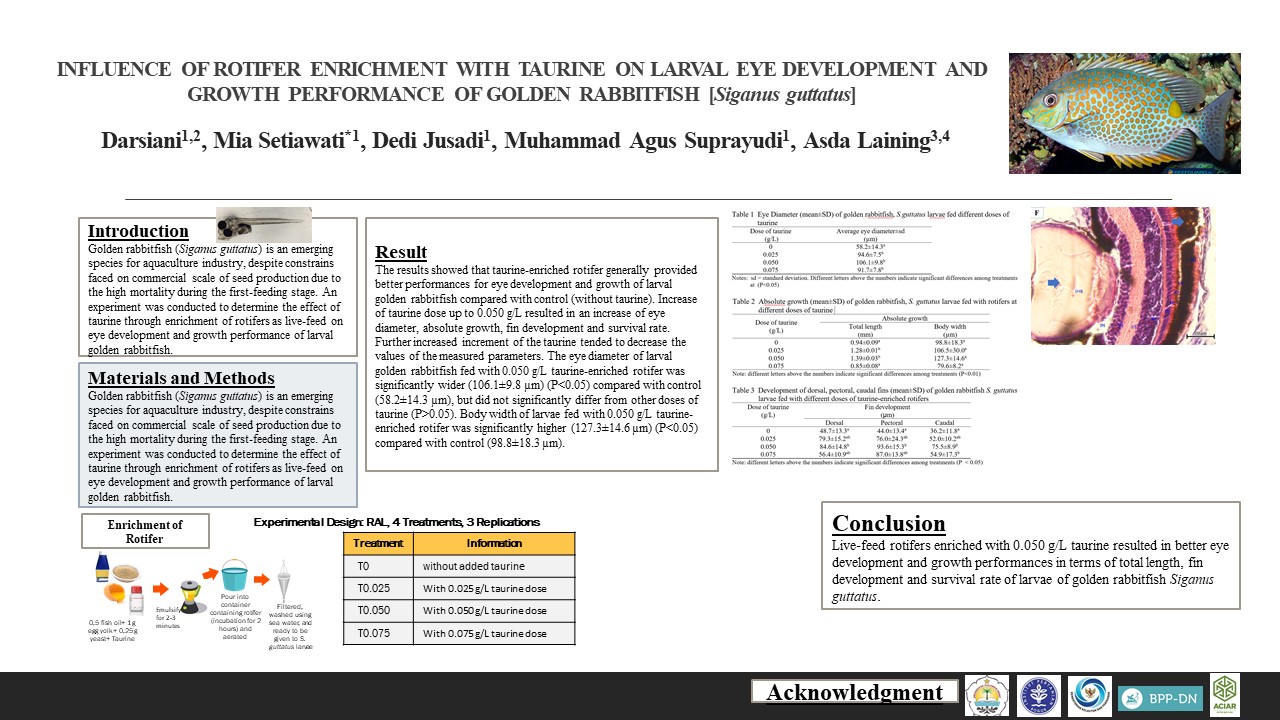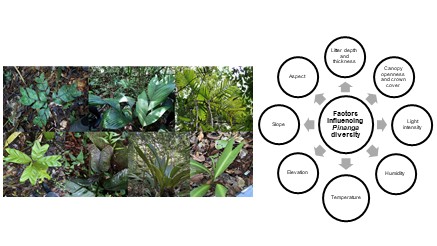Assessment of the Quality of Arabica Coffee Beans from Three Processing Methods and Two Types of Packaging Materials
Downloads
In Southeast Asia, Indonesia is the second highest-producing country of coffee beans after Vietnam. Consequently, Indonesia competes with other countries in producing good quality coffee beans. However, not many people have sufficient skills in tackling problems related to the postharvest handling of these coffee beans. The objective of this study was to assess the quality of Arabica coffee (Coffea arabica) beans in terms of moisture content, fungal infection (especially ochratoxin A or OTA producing fungi), OTA contamination, and the taste of the coffee during storage. The three processing methods used were dry, wet, and semi-wet methods. The beans were packed using two types of packaging materials, i.e. Kantong Semar high gas barrier and polypropylene bags (4 kg/bag). They were then stored under warehouse conditions during 4 months of storage. The moisture content of coffee beans processed using the three methods and packed using polypropylene bags was higher than that of coffee beans packed using Kantong Semar high gas barrier; however, it was still lower than the safe moisture content for coffee determined by the Indonesian National Standard (12.5%). Aspergillus niger was found in coffee processed using the three methods and packed using a Kantong Semar high gas barrier. Its population was relatively low (< 0.1 x 10 cfu/g wet basis). Aspergillus ochraceus was found in coffee processed using dry and wet methods at the beginning of storage. Its population was also relatively low (< 0.3 x 10 cfu/g w.b. OTA content was not detected in all coffee samples, because it was lower than the detection limit of the instrument used (< 1.85 ppb). At the beginning of the storage, all coffee samples were dominated by yeast with the population of 1.9 x 102 – 1.2 x 103 cfu/g w.b. The taste of coffee in various treatments during 4 months of storage was still above the total standard score for specialty grade ≥ 80. The highest total score (84) was found in coffee beans processed using a dry method and packed in Kantong Semar high gas barrier. The three processing methods and the two types of packaging materials can be used to maintain the quality of coffee beans during 4 months of storage.
Keywords: Arabica coffee beans, processing methods, quality, types of packaging materials
Downloads
AOAC Official Method 2004.10. 2012. Ochratoxin A in green coffee. 19th (ed.). In: Latimer GW, editor. Official Methods of Analysis of AOAC International. Gaithersburg (US): AOAC International. Vol II, Chapter 49. pp. 67-9.
Atmawinata O. 2002. Peranan uji citarasa dalam pengendalian mutu kopi [The role of cupping test in controlling the quality of coffee]. Lecture note presented in Training on Cupping Test of Coffee. Jember (ID): Indonesian Research Institute of Coffee and Cacao.
Badan Pengawas Obat dan Makanan [BPOM]. 2018. Peraturan Badan POM Nomor 8 Tahun 2018 tentang batas maksimum cemaran kimia dalam pangan olahan [Regulation of the Head of the Indonesian Agency for Food and Drug Control Number 8 of 2018 concerning chemical contamination in processed food]. Jakarta (ID): Badan POM Republik Indonesia.
Batista LR, SM Chalfoun, CF Silva, M Cirillo, EA Varga, RF Schwan. 2009. Ochratoxin A in coffee beans (Coffea arabica L.) processed by dry and wet methods. Food control 20:784-90. DOI: https://doi.org/10.1016/j.foodcont.2008.10.003
Borem FM, Riberio FC, Figueiredo LP, Giomo GS, Fortunato VA, Isquerdo EP. 2013. Evaluation of the sensory and color quality of coffee beans stored in hermetic packaging. J Stored Product Res 52:1–6. DOI: https://doi.org/10.1016/j.jspr.2012.08.004
Brazil. 2011. Rules on maximum permitted limits for mycotoxins in foods and beverages. Resolution RDC No. 7 of February 18, 2011. Brasilia (BR): Brazilian Ministry of Health.
Bui-Klimke TR, Wu F. 2015. Ochratoxin A and human health risk: A review of the evidence. Crit Rev Food Sci Nutr 55(13):1860-9. Doi: 10.1080/10408398.2012.724480 DOI: https://doi.org/10.1080/10408398.2012.724480
Cabañee FJ, Bragulat MA, Castella G. 2010. Ochratoxin A producing species in the genus Penicillium. Toxins 2:1111-20. Doi: 10.3390/toxins2051111 DOI: https://doi.org/10.3390/toxins2051111
Dharmaputra OS, Ambarwati S, Retnowati I, Nurfadila N. 2019. Fungal infection of stored Arabica coffee (Coffea arabica) beans in Tana Toraja Regency, South Sulawesi Province, Indonesia. BIOTROPIA 26(2):127-35. DOI: https://doi.org/10.11598/btb.2019.26.2.900
de Fatima RE, Borges JG, Cirillo MA, Prado G, Paiva LC, Batista LR. 2013. Ochratoxigenic fungi associated with green coffee beans (Coffea arabica L.) in conventional and organic cultivation in Brazil. Braz J Microbiol 44 (2):377-84. doi: 10.1590/51517-83822013 0002 00006. DOI: https://doi.org/10.1590/S1517-83822013000200006
Evangelista SR, da Cruz Pedroso Miguel MG, Silva CF, Pinheiro ACM, Schwan RF. 2015. Microbiological diversity associated with the spontaneous wet method of coffee fermentation. International Journal of Food Microbiology 210 : 102-112. DOI: https://doi.org/10.1016/j.ijfoodmicro.2015.06.008
Gabungan Eksportir Kopi Indonesia [GAEKI]. 2018. Areal dan produksi kopi [Areal and coffee production. Jakarta (ID): GAEKI; [cited 2018 Oct 31]. Available from: http: //gaeki.or.id/areal-dan-produksi
Kementerian Pertanian Republik Indonesia. 2012. Peraturan Menteri Pertanian RI nomor 52/Permentan/OT.140/9/2012, tanggal 4 September 2012 tentang Pedoman Penanganan Pascapanen Kopi [Regulation of the Ministry of Agriculture, the Republic of Indonesia number OT.140/9/2012 concerning Guidelines of Coffee Postharvest Handling]. Jakarta (ID): Kementerian Pertanian Republik Indonesia. [cited 2019 Nov 13] Available from: ditjenpp.kemenkumham.go.id/arsip/bn/2012/bn909-2012lamp.pdf
Masoud W, Poll L, Jakobsen M. 2005. Influence of volatile compounds produced by yeasts predominant during processing of Coffea arabica in East Africa on growth and ochratoxin A (OTA) production by Aspergillus ochraceus. Yeast: 22:1133-42. DOI: https://doi.org/10.1002/yea.1304
Munyendo LM, Koskei R, Mburu M [Internet]. 2017. Molds and ochratoxin A associated with green coffee (Coffea arabica) beans processed by dry and wet methods in Nyeri Country. IOSR Journal of Environmental Science, Toxicology and Food Technology (IOSR-JESTFT) e- ISSN: 2319-2402, p-ISSN: 2319-2399, Vol 11, Issue 6 Ver. I (June 2017), pp. 66-72. [cited 2017 Oct 15]. Available from www.iosrjournals.org. doi: 10.9790/2402-1106016672 DOI: https://doi.org/10.9790/2402-1106016672
Murthy, PS, Naidu MM. 2011. Improvement of Robusta coffee fermentation with microbial enzymes. European Appl Sci 3(4):130-39.
Pitt JI, Basilico JC, Abarca ML, Lopez C. 2000. Mycotoxins and toxigenic fungi. Medical Mycol 38:41-46. DOI: https://doi.org/10.1080/mmy.38.s1.41.46
Pitt JI, Hocking AD. 2009. Fungi and food spoilage. (3rd ed.). New York (US): Springer. DOI: https://doi.org/10.1007/978-0-387-92207-2_2
Ribeiro FC, Borem FM, Giomo GS, Lima RRD, Malta MR, Figueiredo LP. 2011. Storage of green coffee in hermetic packaging injected with CO2. J Stored Product Res 47:341–48. DOI: https://doi.org/10.1016/j.jspr.2011.05.007
Rosavani MA, Harada H. 2019. Presence of ochratoxin in a green coffee beans processed naturally by smallholder farmers in Jember. Novel Techniques in Nutrition and Food Sci 9(3):270-71. DOI: https://doi.org/10.31031/NTNF.2019.03.000565
Saepudin A. 2005. Evaluasi faktor-faktor yang mempengaruhi citarasa kopi Arabika dengan menggunakan Manova dan analisis profil. (Studi kasus: hasil uji citarasa kopi Arabika Kintamani tahun 2004). [Skripsi]. Bogor (ID): Fakultas Matematika dan Ilmu Pengetahuan Alam IPB. Available from http://repository.ipb.ac.id/handle/123456789/12968
Samson RA, Houbraken J, Thrane U, Frisvad JC, Andersen B. 2010. Food and indoor fungi. CBS Laboratory Manual Series. Utrecht (NL): CBS-KNAW Fungal Biodiversity Centre.
Sunarharum WB, Yuwono SS, Nadhiroh H. 2018. Effect of different postharvest processing on the sensory profile of Java Arabica coffee. Advances in Food Science, Sustainable Agriculture Engineering 1(1) : 9-13. DOI: https://doi.org/10.21776/ub.afssaae.2018.001.01.2
SCAA. 2015. SCAA Protocols; Cupping Specialty Coffee. Specialty Coffee Association of America. [cited 2017 Nov 16]. Available from https://www.scaa.org/PDF/resources/cupping-protocols.pdf
Standar Nasional Indonesia. 2008. Biji kopi [Coffee beans]. Jakarta (ID): Badan Standardisasi Nasional.
Tripetch P, Borompichaichartkul C. 2019. Effect of packaging materials and storage time on changes of colour, phenolic content, chlorogenic acid and antioxidant activity in Arabica green coffee beans (Coffea Arabica L. cv. Catimor). Journal of Stored Products Research 84 : 1-7. DOI: https://doi.org/10.1016/j.jspr.2019.101510
Walton JX [Internet] 2018. Countries produce most coffee. New York (US): Investopedia; [updated 2019 Feb 09; cited 2018 Oct 31]. Available from https://www.investopedia.com/articles/investing.
Copyright (c) 2021 Okky S. Dharmaputra, Santi Ambarwati, Ina Retnowati, Nijma Nurfadila

This work is licensed under a Creative Commons Attribution-NonCommercial-NoDerivatives 4.0 International License.
Authors who publish with this journal agree with the following terms:
- Authors retain copyright and grant the journal right of first publication, with the work 1 year after publication simultaneously licensed under a Creative Commons attribution-noncommerical-noderivates 4.0 International License that allows others to share, copy and redistribute the work in any medium or format, but only where the use is for non-commercial purposes and an acknowledgement of the work's authorship and initial publication in this journal is mentioned.
- Authors are able to enter into separate, additional contractual arrangements for the non-exclusive distribution of the journal's published version of the work (e.g., post it to an institutional repository or publish it in a book), with an acknowledgement of its initial publication in this journal.
- Authors are permitted and encouraged to post their work online (e.g., in institutional repositories or on their website) prior to and during the submission process, as it can lead to productive exchanges, as well as earlier and greater citation of published work (See The Effect of Open Access).


























